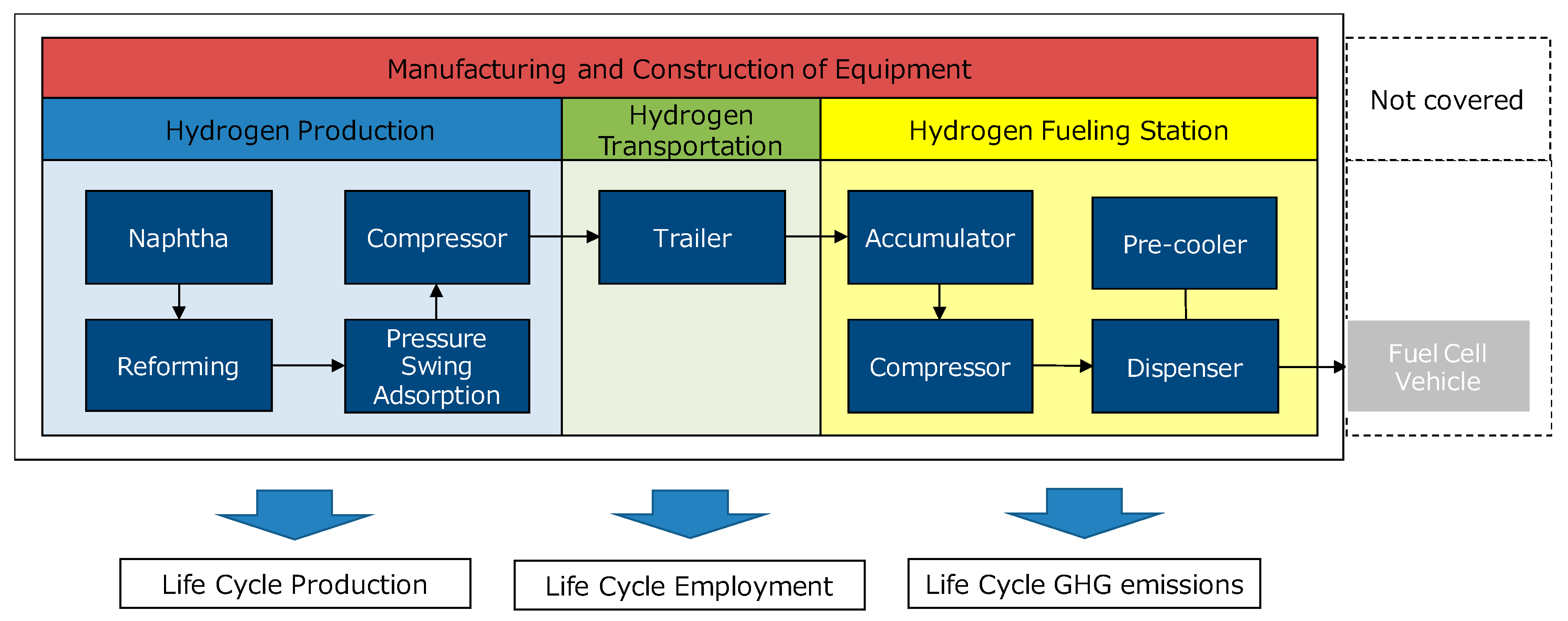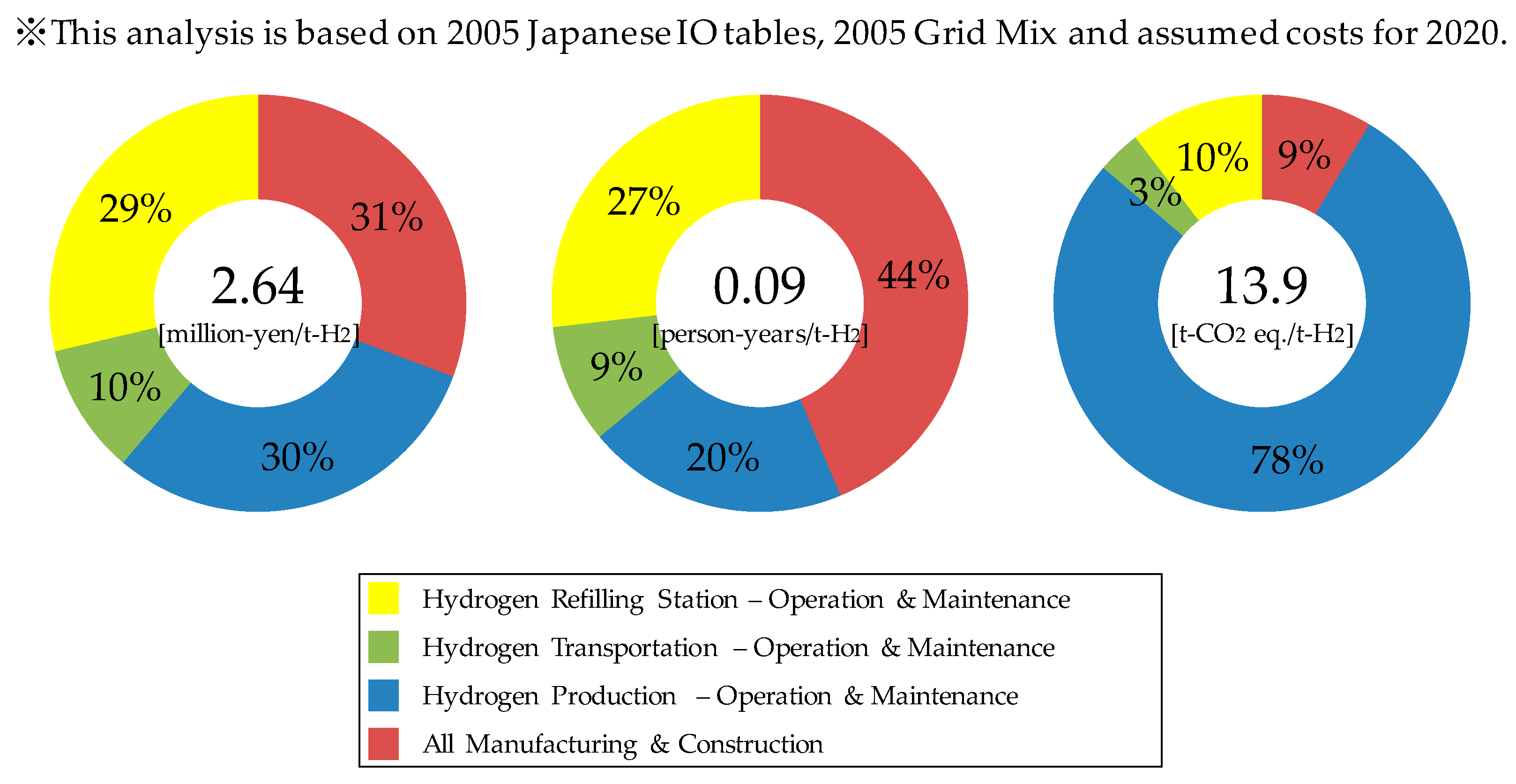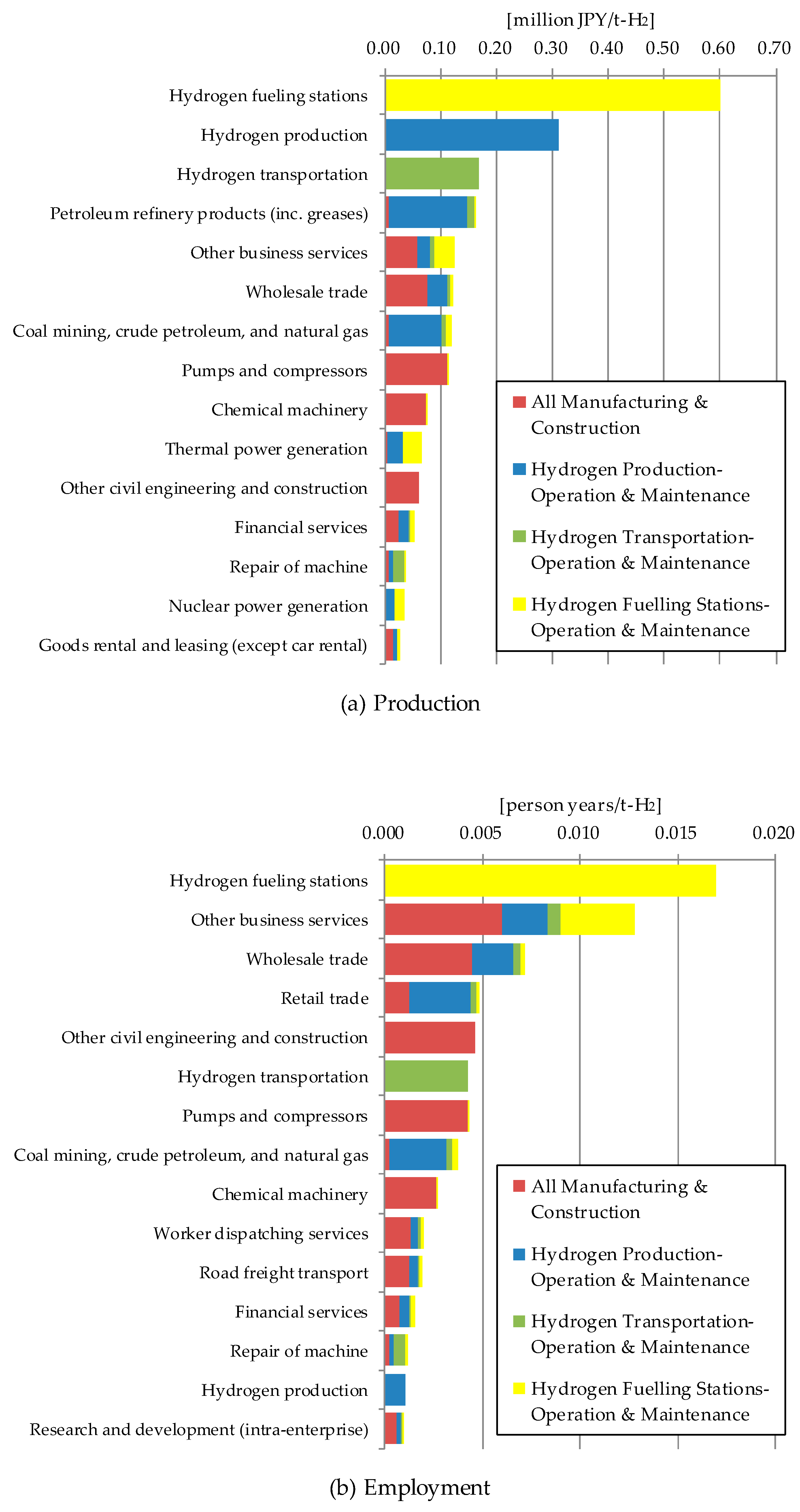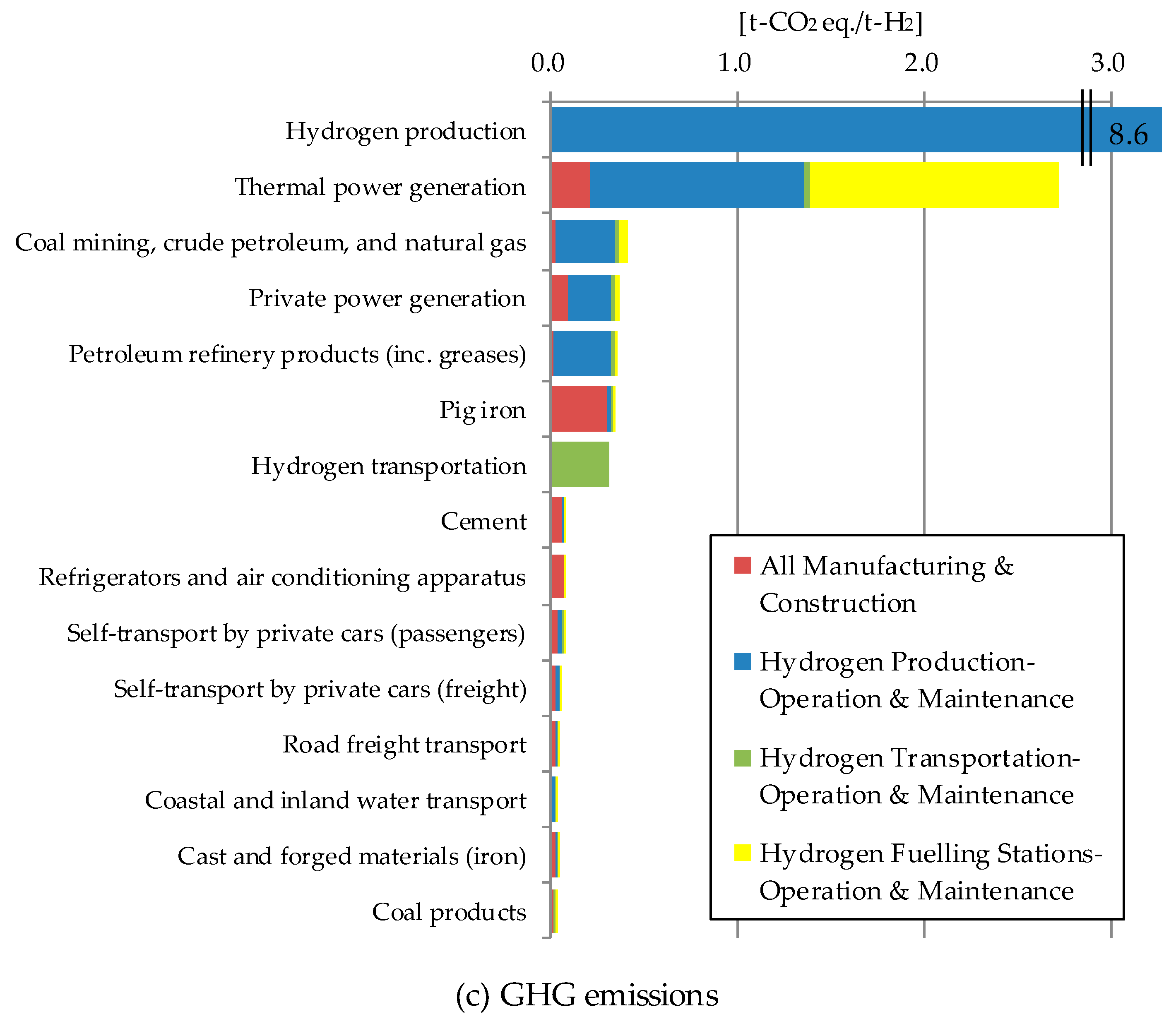Environmental and Socio-Economic Analysis of Naphtha Reforming Hydrogen Energy Using Input-Output Tables: A Case Study from Japan
Abstract
:1. Introduction
2. Materials and Methods
2.1. Input-Output Analysis
2.2. Assumptions of the Hydrogen Energy System
2.3. Established New Sectors
3. Results and Discussion
3.1. Life Cycle Effects
3.2. Sectoral Effects
3.3. Sensitivity Analysis Using Grid Mix Scenarios
4. Conclusions
- Many of the socio-economic analyses of hydrogen energy systems are limited to direct cost calculations, which focus on manufacturing and construction stages. Our study reveals that the effect of production, employment, and GHG emissions during the operation and maintenance stages was also significant. Thus, this study highlights the contributions of different indicators change during the life cycle, confirming that a life cycle perspective using multiple indices is very important for hydrogen energy system analysis.
- The socio-economic effect due to the introduction of the hydrogen energy system is influenced by direct effects of hydrogen production, hydrogen transportation, and hydrogen station, along with indirect effects of raw materials, electrical power, equipment maintenance, and commerce. Specifically, indirect effects of the service sector such as equipment maintenance and commerce among others are highlighted by the input-output table.
- Most of the GHG emissions were discharged during hydrogen production indicating that low-carbon hydrogen production options such as renewable energy can significantly reduce emissions. Additionally, the amount of electricity required for compressor and pre-cooling devices is also significant, and similar active use of low-carbon power generation systems including renewable energy can contribute to a more decarbonized society. The results of the sensitivity analysis also indicate that life cycle of GHG emissions are influenced by changes in the grid mix. However, since low-carbon power generation technology generally tends to be expensive, it is necessary to analyze the trade-off between the expected-positive (GHG emission reduction) and the expected-negative (its cost, stable supply and security, etc.).
- In this study, data regarding hydrogen production using naphtha reforming and high-pressured transportation were employed. However, there are several types of production, including by-product hydrogen and water electrolysis using renewable energy among others. In addition, different types of hydrogen transport are employed for liquefied and organic hydride systems. Future research should address multiple production and transportation methods.
- The input-output table employed in this study assumed the setup to include three sectors: hydrogen production, hydrogen transportation, and hydrogen station. However, future studies should address other factors while accounting for the demand and supply of hydrogen energy.
- All hydrogen energy systems discussed in this research are expressed in terms of 2020 prices as hydrogen energy systems are currently in the initial stage of introduction. Therefore, it is necessary to investigate additional changes in the future, such as price changes and subsidies.
Acknowledgments
Conflicts of Interest
Appendix A
| Life Cycle Stage | Sector | Final Demand [Million-JPY] | |
|---|---|---|---|
| Manufacturing & Construction | Hydrogen Production | Other electrical devices and parts | 99 |
| Pumps and compressors | 146 | ||
| Other business services | 50 | ||
| Wholesale trade | 50 | ||
| Other civil engineering and construction | 30 | ||
| Other Sectors | 4 | ||
| Total | 380 | ||
| Hydrogen Transportation | Chemical machinery | 281 | |
| Trucks, buses, and other cars | 89 | ||
| Wholesale trade | 83 | ||
| Retail trade | 16 | ||
| Road freight transport | 5 | ||
| Other Sectors | 1 | ||
| Total | 476 | ||
| Hydrogen Fueling Station | Pumps and compressors | 729 | |
| Other civil engineering and construction | 549 | ||
| Other business services | 406 | ||
| Chemical machinery | 335 | ||
| Wholesale trade | 297 | ||
| Other Sectors | 305 | ||
| Total | 2619 | ||
| Operation & Maintenance | Hydrogen Production (Established New Sector) * | 2932 * | |
| Hydrogen Transportation (Established New Sector) * | 1597 * | ||
| Hydrogen Fueling Station (Established New Sector) * | 5677 * | ||
Appendix B
| Life Cycle Stage | Sector | Ratio | |
|---|---|---|---|
| Operation & Maintenance | Hydrogen Production | Petroleum refinery products (Inc. greases) | 42.0% |
| Thermal power generation | 10.9% | ||
| Wholesale trade | 8.9% | ||
| Other business services | 5.1% | ||
| Other industrial sectors | 9.1% | ||
| Total added value * | 24.0% * | ||
| Total | 100.0% | ||
| Hydrogen Transportation | Machine repair | 11.9% | |
| Petroleum refinery products (Inc. greases) | 6.5% | ||
| Other business services | 2.9% | ||
| Non-life insurance | 1.8% | ||
| Other industrial sectors | 2.3% | ||
| Total added value * | 74.5% * | ||
| Total | 100.0% | ||
| Hydrogen Fueling Station | Thermal power generation | 7.4% | |
| Other business services | 5.6% | ||
| Hydro and geothermal power generation | 0.9% | ||
| Nuclear power generation | 0.1% | ||
| Other industrial sectors | 0.1% | ||
| Total added value * | 85.9% * | ||
| Total | 100.0% | ||
References
- Intergovernmental Panel on Climate Change (IPCC). Climate Change 2013, The Physical Science Basis. 2013. Available online: http://www.ipcc.ch/report/ar5/wg1/ (accessed on 2 August 2017).
- International Energy Agency (IEA). World Energy Outlook 2015, Executive Summary. 2015. Available online: http://www.worldenergyoutlook.org/weo2015/ (accessed on 13 February 2016).
- Ministry of Economy, Trade and Industry (METI). Strategic Energy Plan; Fiscal 2014. April 2014. Available online: http://www.enecho.meti.go.jp/en/category/others/basic_plan/pdf/4th_strategic_energy_plan.pdf (accessed on 2 August 2017).
- Cabinet Office, Government of Japan (CAO). Energy Innovation 2020; Hydrogen Energy System. 2014. Available online: http://www8.cao.go.jp/cstp/tyousakai/olyparatf/sassi/siryo5.pdf (accessed on 2 August 2017). (In Japanese).
- Elkington, J. Towards the Sustainable Corporation: Win-Win-Win Business Strategies for Sustainable Development. Calif. Manag. Rev. 1994, 36, 90–100. [Google Scholar] [CrossRef]
- Tokyo Metropolitan Government Bureau of Environment (Tokyo Metropolitan). Tokyo Strategy Meeting Summarized toward the Realization of a Hydrogen Society; Fiscal 2015. 2014. Available online: https://www.kankyo.metro.tokyo.jp/energy/tochi_energy_suishin/attachement/26torimatome.pdf (accessed on 7 January 2016). (In Japanese).
- International Organization for Standardization (ISO). ISO Guide 73:2009: Risk Management—Vocabulary. 2009. Available online: https://www.iso.org/obp/ui/#iso:std:44651:en (accessed on 2 August 2017).
- Branscomb, L.M. Sustainable cities: Safety and security. Technol. Soc. 2006, 28, 225–234. [Google Scholar] [CrossRef]
- US Office of Homeland Security. The National Strategy for Homeland Security. 16 July 2002. Available online: https://www.dhs.gov/sites/default/files/publications/nat-strat-hls-2002.pdf (accessed on 2 August 2017).
- Shi, Q.; Liu, Y.; Zuo, J.; Pan, N.; Ma, G. On the management of social risks of hydraulic infrastructure projects in China: A case study. Int. J. Proj. Manag. 2015, 33, 483–496. [Google Scholar] [CrossRef]
- McLellan, B.; Zhang, Q.; Farzaneh, H.; Utama, N.A.; Ishihara, K.N. Resilience, sustainability and risk management: A focus on energy. Challenges 2012, 3, 153–182. [Google Scholar] [CrossRef]
- Kinehara, Y.; Noguchi, K.; Inoue, R.; Takahashi, H.; Shibuya, Y.; Nagano, M. New Treatise on How to Enrich Our Country. 2008. Available online: http://www.mri.co.jp/NEWS/magazine/journal/47/__icsFiles/afieldfile/2008/10/21/jm06111504.pdf (accessed on 2 August 2017). (In Japanese with English Summary).
- Noguchi, K. Seeking the Form of a New Country (1); Looking to the Questionnaire Survey “New Treatise on How to Enrich Our Country”; What Is the Richness of Japanese People Think. 2011. Available online: http://diamond.jp/articles/-/13390 (accessed on 2 August 2017). (In Japanese).
- Sakamoto, J.; Nakayama, J.; Nakarai, T.; Kasai, N.; Shibutani, T.; Miyake, A. Effect of gasoline pool fire on liquid hydrogen storage tank in hybrid hydrogen–gasoline fueling station. Int. J. Hydrogen Energy 2016, 41, 2096–2104. [Google Scholar] [CrossRef]
- Nakayama, J.; Sakamoto, J.; Kasai, N.; Shibutani, T.; Miyake, A. Preliminary hazard identification for qualitative risk assessment on a hybrid gasoline-hydrogen fueling station with an on-site hydrogen production system using organic chemical hydride. Int. J. Hydrogen Energy 2016, 41, 7518–7525. [Google Scholar] [CrossRef]
- Okada, Y. Safety of hydrogen storage and transportation system by organic chemical hydride method. J. Hydrogen Energy Syst. Soc. Jpn. 2010, 35, 19–24, (In Japanese with English Abstract). [Google Scholar]
- Ono, K.; Tsunemi, K. Identification of public acceptance factors with risk perception scales on hydrogen fueling stations in Japan. Int. J. Hydrogen Energy 2017, 42, 10697–10707. [Google Scholar] [CrossRef]
- Itoh, T. Hydrogen Supply Case Studies and Economic Evaluation. 2003. Available online: http://www.pecj.or.jp/japanese/report/reserch/report-pdf/H15_2003/03cho3-3.pdf (accessed on 2 August 2017). (In Japanese).
- Kanoh, T. Current Status of Producing Hydrogen as By-Product and Technology for Utilization. Best Value, 20 Theme 7. 2008. Available online: http://www.vmi.co.jp/info/bestvalue/pdf/bv20/bv20_07.pdf (accessed on 10 March 2016). (In Japanese).
- Nakamura, T.; Iwabuchi, H.; Murata, K.; Sakata, K. Supply Cost and Technology Issues of Hydrogen for Fuel Cell Vehicles. J. Hydrogen Energy Syst. Soc. Jpn. 2008, 33, 27–34, (In Japanese with English abstract). [Google Scholar]
- Kokubun, Y. Cost and energy efficiency in transportation of high pressure hydrogen. J. Hydrogen Energy Syst. Soc. Jpn. 2009, 34, 24–30, (In Japanese with English abstract). [Google Scholar]
- Matsuo, Y.; Hirai, H.; Uno, J.; Nagatomi, Y. Hydrogen Energy as Automotive Fuel. 2010. Available online: https://eneken.ieej.or.jp/data/3098.pdf (accessed on 2 August 2017). (In Japanese with English Abstract).
- Japan Hydrogen & Fuel Cell Demonstration Project (JHFC). Fuel Cell System Empirical Research Report (Phase 2 JHFC Project); Fiscal 2011. 2011. Available online: http://www.jari.or.jp/Portals/0/jhfc/data/report/pdf/tuuki_phase2_01.pdf (accessed on 2 August 2017). (In Japanese).
- Yamashita, Y.; Yoshino, Y.; Yoshimura, K.; Shindo, K.; Harada, E. Feasibility study on the hydrogen energy supply chain for low carbon society. J. Jpn. Soc. Energy Resour. 2014, 35, 11–19, (In Japanese with English Abstract). [Google Scholar]
- Hondo, H.; Moriizumi, Y.; Usui, T. Life Cycle Environmental Analysis of Hydrogen Storage Technology Using Organic Hydride: Energy Requirement and CO2 Emission. J. Jpn. Inst. Energy 2008, 87, 753–762, (In Japanese with English Abstract). [Google Scholar]
- Usui, T.; Hondo, H. Life Cycle CO2 Emission Analysis of Hydrogen Storage and Battery for Wind Power Generation. J. Jpn. Inst. Energy 2010, 89, 551–561, (In Japanese with English Abstract). [Google Scholar] [CrossRef]
- Japan Automobile Research Institute (JARI). Overall Efficiency and Analysis of GHG Emissions. 2011. Available online: http://www.jari.or.jp/Portals/0/jhfc/data/report/2010/pdf/result.pdf (accessed on 2 August 2017). (In Japanese).
- Toyota Motor Corporation. The MIRAI LCA Report for Communication. 2015. Available online: https://www.toyota.co.jp/jpn/sustainability/environment/low_carbon/lca_and_eco_actions/pdf/life_cycle_assessment_report.pdf (accessed on 2 August 2017). (In Japanese).
- Mizuho Information & Research Institute, Inc. Evaluation Report on Greenhouse Gas Emissions of Hydrogen Considering Life Cycle (Overview Version). 2016. Available online: https://www.mizuho-ir.co.jp/publication/report/2016/pdf/wttghg1612.pdf (accessed on 2 August 2017). (In Japanese).
- Lambert, R.J.; Silva, P.P. The challenges of determining the employment effects of renewable energy. Renew. Sustain. Energy Rev. 2012, 16, 4667–4674. [Google Scholar] [CrossRef]
- Lehr, U.; Nitsch, J.; Kratzat, M.; Lutz, C.; Edler, D. Renewable energy and employment in Germany. Energy Policy 2008, 36, 108–117. [Google Scholar] [CrossRef]
- Markaki, M.; Belegri-Roboli, A.; Michaelides, P.; Mirasgedis, S.; Lalas, D.P. The impact of clean energy investments on the Greek economy: An input–output analysis (2010–2020). Energy Policy 2013, 57, 263–275. [Google Scholar] [CrossRef]
- Matsumoto, N.; Hondo, H. Analysis on Employment Effects of the Introduction of Renewable Energy Technologies Using an Extended Input-output Table. J. Jpn. Inst. Energy 2011, 90, 258–267, (In Japanese with English Abstract). [Google Scholar] [CrossRef]
- Hienuki, S.; Kudoh, Y.; Hondo, H. Life cycle employment effect of geothermal power generation using an extended input–output model: The case of Japan. J. Clean. Prod. 2015, 93, 203–212. [Google Scholar] [CrossRef]
- Hienuki, S.; Kudoh, Y.; Hondo, H. Establishing a Framework for Evaluating Environmental and Socio-Economic Impacts by Power Generation Technology Using an Input–output Table—A Case Study of Japanese Future Electricity Grid Mix. Sustainability 2015, 7, 15794–15811. [Google Scholar] [CrossRef]
- Moriizumi, Y.; Hondo, H.; Nakano, S. Development and Application of Renewable Energy-Focused Input-Output Table. J. Jpn. Inst. Energy 2015, 94, 1397–1413, (In Japanese with English Abstract). [Google Scholar] [CrossRef]
- Lee, D.H.; Lee, D.J.; Chiu, L.H. Biohydrogen development in United States and in China: An input–output model study. Int. J. Hydrogen Energy 2011, 36, 14238–14244. [Google Scholar] [CrossRef]
- Chun, D.; Woo, C.; Seo, H.; Chung, Y.; Hong, S.; Kim, J. The role of hydrogen energy development in the Korean economy: An input-output analysis. Int. J. Hydrogen Energy 2014, 39, 7627–7633. [Google Scholar] [CrossRef]
- Ministry of Internal Affairs and Communications (MIAC). Input-Output Tables. 2015. Available online: http://www.e-stat.go.jp/SG1/estat/ListE.do?bid=000001060671&cycode=0 (accessed on 1 March 2016).
- Ministry of Internal Affairs and Communications (MIAC). Input-Output Tables. 2009. Available online: http://www.soumu.go.jp/english/dgpp_ss/data/io/io05.htm (accessed on 1 March 2016).
- Center for Global Environmental Research, National Institute for Environmental Studies (CGER). Embodied Energy and Emission Intensity Data for Japan Using Input–Output Tables (3EID): For 2005 IO Table. 2013. Available online: http://www.cger.nies.go.jp/publications/report/d031/index.html (accessed on 4 May 2014).
- Ministry of Economy, Trade and Industry (METI). For Hydrogen and Fuel Cell; Fiscal 2013. 2013. Available online: http://www.enecho.meti.go.jp/committee/council/basic_policy_subcommittee/008/pdf/008_008.pdf (accessed on 2 August 2017). (In Japanese)
- JX Nippon Oil & Energy Corporation (JX). Changes in Crude Oil Processing Capacity/Throughput/Capacity Utilization. 2014. Available online: http://www.noe.jx-group.co.jp/binran/data/pdf/40.pdf (accessed on 20 February 2016). (In Japanese).
- World Bank. Official Exchange Rate (LCU per US$, Period Average). Available online: http://data.worldbank.org/indicator/PA.NUS.FCRF?page=1 (accessed on 20 February 2016).
- Fuji Keizai Co., Ltd. (Fuji). Future Prospects of Hydrogen Fuel-Related Markets (Fiscal 2017 Edition). 2017. Available online: https://www.fuji-keizai.co.jp/report/index/141609842.html (accessed on 2 August 2017). (In Japanese).
- Ministry of the Environment (MoE). Calculation Methods and Emission Coefficients List in Accounting and Reporting System. 2015. Available online: http://ghg-santeikohyo.env.go.jp/files/calc/itiran.pdf (accessed on 19 January 2015). (In Japanese)
- The Federation of Electric Power Companies of Japan. Power Statistics Information. 2017. Available online: http://www.fepc.or.jp/library/data/tokei/index.html (accessed on 19 June 2017). (In Japanese).





| Activity | Amount/Rate | Unit | Reference | ||
|---|---|---|---|---|---|
| Hydrogen Production | Supply capacity | 1500 | Nm3/h | [23] | |
| Business hours | 24 | h | |||
| Utilization rate | 0.8 | - | [43] | ||
| Lifetime | 10 | years | [23] | ||
| Employment | 1 | person-years | |||
| Hydrogen Transportation | Trailer | Number for detainment | 8 | unit | [23] |
| Number for transportation | 2 | unit | |||
| Number for filling | 2 | unit | |||
| Lifetime | 10 | years | |||
| Tractor | Number | 2 | cars | ||
| Lifetime | 5 | years | |||
| Diesel oil consumption | 50 | l/time/car | |||
| Transport frequency | 4 | time/car | |||
| Running number | 2 | car/day | |||
| Transport distance (round trip) | 100 | km/time | |||
| Utilization rate | 0.8 | - | * | ||
| Employment | 4 | person-years | [23] | ||
| Hydrogen Fueling Station | Type | Off-site | [23] | ||
| Supply capacity | 300 | Nm3/h | |||
| Business hours | 15 | h/day | * | ||
| Number | 8 | places | [23] | ||
| Lifetime | 10 | years | |||
| Utilization rate | 0.8 | - | * | ||
| Employment (8 stations total) | 16 | person-years | [23] | ||
| Activity | Life Cycle Stage | Goods and Services | Cost [Million-JPY] | References |
|---|---|---|---|---|
| Hydrogen Production | Manufacturing & Construction | PSA (Pressure Swing Adsorption) | 70 | [23] |
| Hydrogen compressor | 101 | |||
| Suction drum | 4 | |||
| Off-gas compressor | 11 | |||
| Piping, installation, instrumentation, electrical equipment | 113 | |||
| Civil engineering and construction | 30 | |||
| Engineering | 51 | |||
| Operation & Maintenance | Naphtha (raw material) | 1616 | ||
| Naphtha (fuel) | 54 | |||
| Power | 361 | |||
| Clean water | 22 | |||
| Personnel expenses | 70 | |||
| Repair costs | 114 | |||
| Insurance fee | 23 | |||
| Property tax | 53 | |||
| Overhead | 38 | |||
| Value added except for depreciation cost | 200 | [23,39] | ||
| Total | 2932 | - | ||
| Hydrogen Transportation | Manufacturing & Construction | Hydrogen trailer (45 MPa) | 336 | [23] |
| Undercarriage | 96 | |||
| Tractor | 44 | |||
| Operation & Maintenance | Maintenance | 190 | ||
| Insurance fee | 29 | |||
| Property tax | 67 | |||
| Overhead | 48 | |||
| Fuel cost | 140 | |||
| Personnel expenses | 280 | |||
| Value added for depreciation cost | 200 | [23,39] | ||
| Total | 1597 | - | ||
| Hydrogen Fueling Stations | Manufacturing & Construction | Accumulator (high and low pressure) | 210 | [45] |
| Compressor (filling) | 720 | |||
| Hydrogen dispenser | 400 | |||
| Pre-cooler equipment | 240 | |||
| Hydrogen valve | 63 | |||
| Hydrogen sensor | 26 | |||
| Engineering | 411 | |||
| Civil engineering and construction | 549 | |||
| Operation & Maintenance | Maintenance | 324 | ||
| Power | 476 | [23] | ||
| Personnel expenses | 1600 | [45] | ||
| Value added for depreciation cost | 200 | [23,39] | ||
| Total | 5677 | - | ||
| Sector | Input Coefficients-Column- | Output Coefficients-Row- | Employment Coefficients | GHG Emissions Coefficient |
|---|---|---|---|---|
| Hydrogen Production | Publication information [23,43,45] | Zero vector | Publication information [23,43,45] | Publication information [23,46] |
| Hydrogen Transportation | ||||
| Hydrogen Fueling Station | ||||
| Nuclear Power Generation | Basic table of original input-output table in 2005 [40] | Disaggregation of grid mix in 2005 or any year [47] | Employment table of original IO in 2005 [40] Number of employees of each type of power generation in 2005 [47] | 3EID (Embodied Energy and Emission Intensity Data for Japan) [41] |
| Thermal Power Generation | ||||
| Hydro and Geothermal Power Generation |
| Grid Mix | Production [Million-Yen/t-H2] | Employment [Person-Years/t-H2] | GHG Emissions [t-CO2 eq./t-H2] | ||
|---|---|---|---|---|---|
| 2005 (Scenario 1) | Nuclear | 31% | 2.64 (Base) | 0.09 (Base) | 13.9 (Base) |
| Thermal | 60% | ||||
| Hydro & Geothermal | 9% | ||||
| Mean of 2000 and 2015 (Scenario 2) | Nuclear | 16% | 2.65 (+0.4%) | 0.09 (+0.4%) | 14.6 (+4.9%) |
| Thermal | 74% | ||||
| Hydro & Geothermal | 9% | ||||
| 2015 (Scenario 3) | Nuclear | 1% | 2.67 (+0.8%) | 0.09 (+0.8%) | 15.3 (+9.9%) |
| Thermal | 89% | ||||
| Hydro & Geothermal | 10% | ||||
© 2017 by the author. Licensee MDPI, Basel, Switzerland. This article is an open access article distributed under the terms and conditions of the Creative Commons Attribution (CC BY) license (http://creativecommons.org/licenses/by/4.0/).
Share and Cite
Hienuki, S. Environmental and Socio-Economic Analysis of Naphtha Reforming Hydrogen Energy Using Input-Output Tables: A Case Study from Japan. Sustainability 2017, 9, 1376. https://doi.org/10.3390/su9081376
Hienuki S. Environmental and Socio-Economic Analysis of Naphtha Reforming Hydrogen Energy Using Input-Output Tables: A Case Study from Japan. Sustainability. 2017; 9(8):1376. https://doi.org/10.3390/su9081376
Chicago/Turabian StyleHienuki, Shunichi. 2017. "Environmental and Socio-Economic Analysis of Naphtha Reforming Hydrogen Energy Using Input-Output Tables: A Case Study from Japan" Sustainability 9, no. 8: 1376. https://doi.org/10.3390/su9081376




